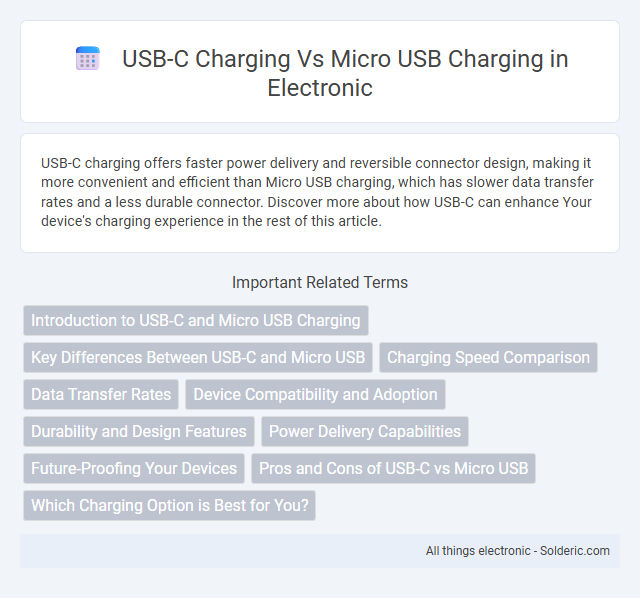USB-C charging offers faster power delivery and reversible connector design, making it more convenient and efficient than Micro USB charging, which has slower data transfer rates and a less durable connector. Discover more about how USB-C can enhance Your device's charging experience in the rest of this article.
Comparison Table
| Feature | USB-C Charging | Micro USB Charging |
|---|---|---|
| Connector Shape | Reversible, oval design | Non-reversible, trapezoidal |
| Charging Speed | Supports up to 100W (Power Delivery) | Typically up to 15W |
| Data Transfer Speed | Up to 10 Gbps (USB 3.1) | Up to 480 Mbps (USB 2.0) |
| Compatibility | Modern devices, universal standard | Older devices, limited compatibility |
| Durability | Stronger connector, higher lifespan | Less durable, prone to wear |
| Video Output | Supports DisplayPort and HDMI alt modes | Not supported |
| Future-Proofing | Widely adopted as industry standard | Being phased out |
Introduction to USB-C and Micro USB Charging
USB-C charging offers faster data transfer rates and higher power delivery compared to Micro USB, supporting up to 100W of power for quick device charging. Micro USB, widely used in older smartphones and accessories, provides slower charging speeds and limited power capacity, typically maxing out at 15W. USB-C's reversible connector design enhances user convenience while enabling compatibility with modern devices and accessories across multiple brands.
Key Differences Between USB-C and Micro USB
USB-C offers reversible plug orientation and supports higher power delivery up to 100W, enabling faster charging compared to Micro USB's limited 5W to 15W capacity. Data transfer speeds with USB-C reach up to 10 Gbps through USB 3.1 or Thunderbolt 3 technology, while Micro USB typically maxes out at 480 Mbps with USB 2.0 standards. The universal compatibility of USB-C with modern devices enhances convenience, replacing the older Micro USB which remains common in budget devices and accessories.
Charging Speed Comparison
USB-C charging outperforms Micro USB in speed due to its support for higher power delivery, enabling fast charging up to 100 watts compared to Micro USB's typical maximum of 15 watts. This significant difference allows USB-C devices to recharge significantly faster, reducing downtime for smartphones, tablets, and laptops. Advanced USB Power Delivery protocols also enable dynamic voltage adjustment, further optimizing charging efficiency beyond micro USB capabilities.
Data Transfer Rates
USB-C charging supports significantly higher data transfer rates, with USB 3.1 offering speeds up to 10 Gbps, compared to Micro USB's USB 2.0 standard, which maxes out at 480 Mbps. This makes USB-C ideal for transferring large files quickly and efficiently. Your devices will benefit from reduced transfer times and enhanced performance when using USB-C connections.
Device Compatibility and Adoption
USB-C charging offers broader device compatibility as it supports a wide range of modern smartphones, laptops, tablets, and peripherals, while Micro USB remains limited mostly to older or budget devices. USB-C adoption has surged due to its reversible connector, faster data transfer, and higher power delivery capabilities, becoming the new industry standard across various brands and platforms. Choosing USB-C ensures future-proofing your devices and access to faster, more versatile charging solutions.
Durability and Design Features
USB-C charging offers superior durability compared to Micro USB, featuring a reversible connector design that reduces wear and tear from incorrect insertions. Its robust, symmetrical shape enhances plug longevity and eliminates orientation frustration common with Micro USB's asymmetrical design. Your device benefits from faster, more reliable power transfer and less frequent cable replacement with USB-C technology.
Power Delivery Capabilities
USB-C charging supports Power Delivery (PD) standards allowing up to 100W of power transfer, enabling faster and more efficient charging for a wide range of devices from smartphones to laptops. Micro USB typically delivers lower power, maxing out around 15W, which limits its ability to charge larger devices quickly. Your choice of USB-C ensures compatibility with higher wattage chargers and rapid charging technologies, improving overall device performance and charging speed.
Future-Proofing Your Devices
USB-C charging offers significantly faster data transfer and higher power delivery compared to Micro USB, making it a future-proof choice for your devices. With widespread adoption across smartphones, laptops, and accessories, USB-C ensures compatibility with upcoming technology standards and reduces the need for multiple chargers. Choosing USB-C charging enhances convenience and longevity, protecting your investment as device requirements evolve.
Pros and Cons of USB-C vs Micro USB
USB-C charging offers faster data transfer speeds and higher power delivery up to 100W, enabling quicker device charging compared to the older Micro USB standard, which typically supports lower wattage and slower transmission. USB-C's reversible connector design improves user convenience and durability, while Micro USB is more prone to wear due to its asymmetrical shape and fragile pins. However, Micro USB remains widely compatible with older devices and accessories, making it a more economical choice for legacy systems despite its limitations in speed and power.
Which Charging Option is Best for You?
USB-C charging offers faster data transfer speeds and higher power delivery compared to Micro USB, making it ideal for quickly charging modern smartphones, laptops, and tablets. Micro USB remains compatible with older devices but lacks the reversible connector and efficiency found in USB-C. Your choice depends on device compatibility and charging speed preferences, with USB-C generally providing a more future-proof and convenient option.
USB-C charging vs Micro USB charging Infographic

 solderic.com
solderic.com